Reports
Good ideas that made it into start-up companies
7 Feb 2024
In this fascinating event held at Durham University, we explored the pathways that can take individual bright scientific ideas from academia to start-up company and beyond.
We heard from two academics, Professor Carrie Ambler (Light-Ox), and Dr Chris Saunter (Magnitude Biosciences) about how they became interested in science in their formative years, chose University courses and eventually obtained academic positions at Durham University - Carrie in the Department of Biosciences and Chris in the Department of Physics. It was during their roles as academics that they each formed research collaborations with other academics from different disciplines - Carrie with Chemists, Chris with biologists. These collaborations formed the basis of their spin-out companies, with developments in light-activated cytotoxic chemicals for cancer therapies (Light-Ox) and automated imaging of the growth and development of the nematode C. elegans for rapid drug screening (Magnitude Biosciences).
What was interesting was the non-linear route by which both Carrie and Chris arrived at their current roles, which sent an important message to the audience that there is more than one way to succeed at the science-technology-industry interface. We heard about the challenges they faced and - what came across strongly - the enthusiasm for taking this rather unconventional route (for many academics) into the world of translation of their research interests into something on commercial value and utility.
There were plenty of questions from the audience, which comprised a high proportion of early career researchers intrigued by the pathways taken by the energetic and open speakers.
Professor Keith Lindsey FRSB
A visit to Fujifilm Diosynth Biotechnologies: processes and careers in the biopharmaceutical sector
18 October 2023
Ten members of the Northern Branch enjoyed a very interesting day's visit to FUJIFILM Diosynth Biotechnologies (FDB) located in Billingham, Teesside in October.

Developed from the old ICI plant, we were treated to tours of the research and manufacturing facilities and given a series of fascinating presentations explaining the activities carried out. FDB works in partnership with a wide range of client customers in the healthcare sector to develop and manufacture biologics, vaccines, cell and gene therapies and oncolytic viruses. We heard about therapeutic protein production systems using both microbial (bacterial, yeast) and mammalian cell culture systems, and cell and viral gene therapy technologies.
FDB recently was, during the pandemic, contracted to develop a new RNA vaccine as a therapy for COVID-19. While the company works with clients from the healthcare sector, we heard how the process development team works with robotic platform technologies to improve the efficiency of protein expression and screening for purification strategies in both microbial and mammalian cells. FDB also collaborates with other companies to develop innovative technologies for selecting high producing cell lines.
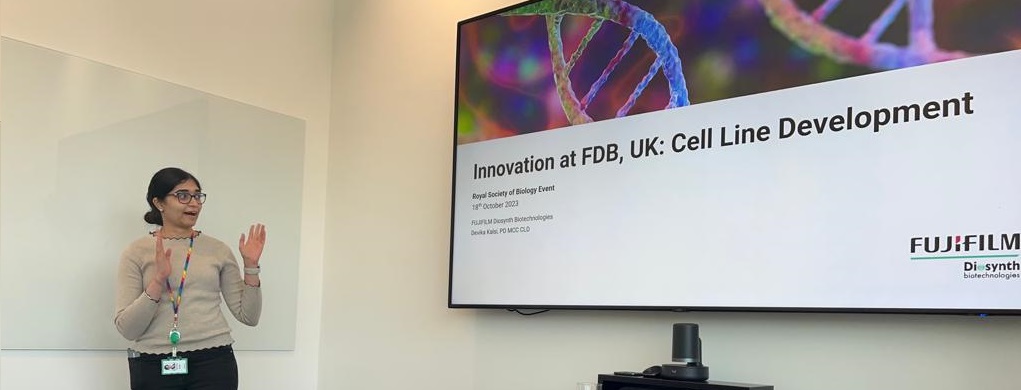
It was fascinating to get a sense of the pipeline of activities, the range of skills required, and the technical challenges faced in working at this scale. It was also interesting to hear from recent and more established staff at FDB about their (quite different) career paths that led them to Billingham, whether as scientists with postdoctoral and previous industrial experience or as school leavers on an apprenticeship scheme that allows part-time study for a degree.
We'd like to thank FDB for the time taken to entertain us, and for the excellent lunch!
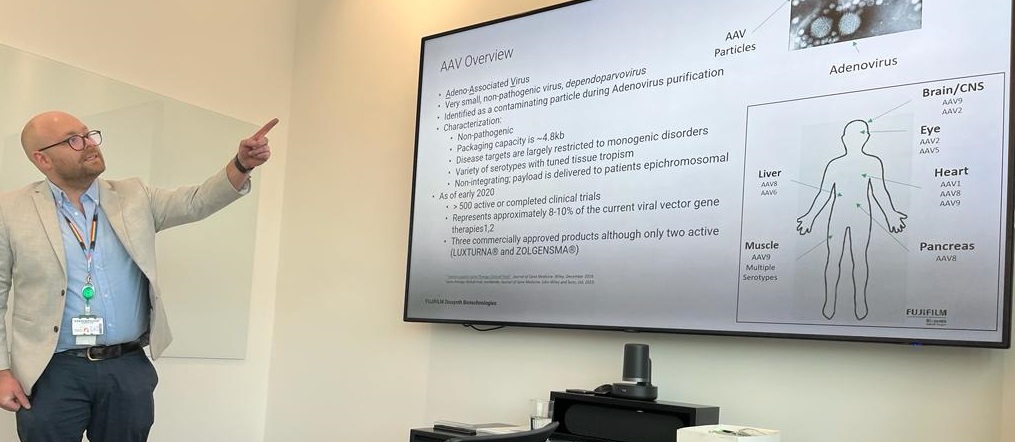
Professor Keith Lindsey FRSB
Regenerative Farming (making space for nature)
1 July 2023
Three generations of the Stephenson family welcomed the Northern Branch to their home at Bradley Hall Farm. This mixed livestock/ arable farm was the venue for a fascinating walk around the surrounding fields discussing modern farming practices with more than a nod to effective nature conservation. Catherine Stephenson is a committee member of the Northern branch.
Bradley Hall today is a functional and beautiful home with scheduled ruins attached. However, in the seventeenth century it was a great and fashionable house and three hundred years earlier a large and defensible home with a protective moat and earthen embankments, the remains of which can still be seen today. To the south side of the house are the outlines of medieval fishponds and a pillow mound (where rabbits were encouraged to burrow and breed).
We were shown around a newly planted orchard (where grazing can still take place) and multi species herbal leys (sown pastures made up of rye grass, red and white clover, chicory etc.). Fields of rye grass were being cut for silage whilst hedge planting (a funding-approved commercially bought mix of hawthorn, hazel and dog rose) provides both field boundaries and wildlife corridors within the farm. Tall grass grazing is used with the beef cattle with the intention of creating plant structural diversity in the fields and trampling pushing nutrients back into the soil. Interestingly, the cattle are moved in blocks twice a day, penned by electric fences. The idea of putting them together tightly appears to be an effective method of ensuring efficient grazing together with a high degree of animal security (rather like the natural situation of bovines in a herd).

Members learning about regenerative farming practices
Regenerative farming means different things to different farmers, but ultimately it focuses on soil health with very little use of introduced chemicals and minimal soil disturbance. The World Economic Forum in 2022 pointed out that "more than half of the world's agricultural land is degraded." Regenerative farming can therefore reduce carbon dioxide release from the soil (by reducing tilling), promote water retention and drought resistance (by trampled surface vegetation and deeper-rooted plants) and promote biodiversity. Such a farming practice certainly seems to work. Soil organic matter has increased at Bradley Hall Farm from 1% to 5% over the years and traditional insecticides haven't been used for 4 years.
However, in spite of these enlightened management strategies, this is still a working farm with costs to be met and a living to be made. Nitrate application on grass has been reduced from 200kg to 40kg NO3/ha due to a package of measures including mob grazing, inclusion of legumes and foliar application. They have reduced application on wheat from 200kg to 140kg NO3/ha by foliar application, and having more grass and legumes in the arable rotation. The farm is working towards further reductions without sacrificing yield. Fungicides are still used though to control rust and herbicides to deal with grass weeds (there through an absence of ploughing). Government grants have been used to buy hedges and will hopefully be used to maintain water courses on the land, and although practices of rotational grazing have been used for centuries, modern soil science and pest management strategies are proving to be very successful.

Part of Bradley Hall Farm
The Stephenson's have managed to combine a successful working farm with enhanced soil fertility and the opportunity to promote local wildlife in the Wear Valley. We came away both enlightened and amazed, and the rather excellent ploughman's lunch that was provided at the end of the visit (ironic seeing as how there is very little ploughing!) was most welcome.
Dr Mike Cassidy CBiol FRSB
Online talk series 2021
It’s not all grim up north: Some positives from Lockdown
January-June 2021
Although we couldn’t meet in person and we were concerned that everyone was ‘zoomed out’, the Northern branch has enjoyed very well attended and stimulating monthly virtual talks in 2021.
We might not have been able actually to travel or socialise, but we have heard about overseas research, the importance of collaboration and teamwork in science, as well as reminders of dedication paying off in our talks.
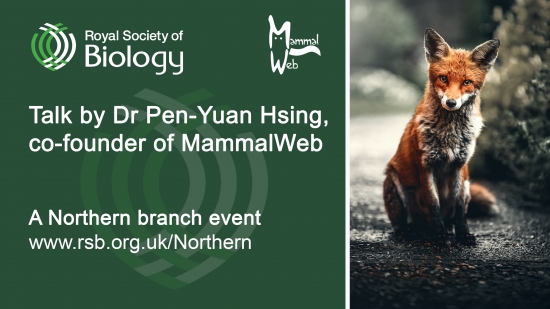
Innovative work in the field in Africa featured in two of our talks. Professor Steve Lindsay’s experimental work on house design to reduce the threat from mosquitoes included ingeniously raising houses to different heights; and fieldwork to determine environmental factors affecting early hominid distribution described by Professor Patrick Randolph-Quinney involved GPS and volunteers wearing rectal thermometers. Professor Nicola Curtin explained how collaborations and serendipitous circumstances were vital in the successful development of rucaparib, a cancer drug; while both Dr Pen-Yuan Hsing and Jean Wilson MBE inspired us with the power of citizen science projects. Following Professor Keith Lindsey’s talk about his years of studying plant growth strategies one participant claimed that they’d “forgotten how exciting plants were!”. Recordings of the branch’s online events can be viewed on the Society’s YouTube channel.
Further talks are in the pipeline and we hope to travel and meet at events in person in 2022.
All these activities are planned by the Northern branch committee who are always looking for new ideas to engage biologists – young and not so young - in the region. If you’d like to join us, especially if you have an interest in being able to promote our sessions via social media, please get in touch at northern@rsb.org.uk
Ros Roberts CBiol FRSB
The Well-tempered Mind online talk
17 September 2020
Marcus Kaiser FRSB, professor of neuroinformatics in the School of Computing at Newcastle University, led our second virtual zoominar in September. Marcus’s talk was on ‘The Well-tempered Mind: How Brain Connectivity is Linked to Cognition’. The talk was very clear and was followed by a detailed question and answer session. The talk will soon be available to listen for those who were not able to join the event.
Professor Caroline Austin FRSB
Arctic terns online talk from Dr Chris Redfern
16 July 2020
The RSB Northern branch's first virtual event was held on Thursday 16th July at 19:00, the highlight of which was a talk on Arctic terns by Dr Chris Redfern. The talk was very clear and provided attendees with highly detailed information. This was followed by a detailed question and answer session, and an informal chat between attendees, the speaker and the Northern branch committee. 33 people used Zoom to hear Chris’s talk.
Chris described the studies that revealed the migratory paths of Arctic terns, using tiny geolocators attached to the leg of these fascinating birds. They travel all the way to the Antarctic to enjoy the sea ice krill. The longitudinal nature of the study spanning 2015-2017 sheds light on changes in sea ice distributions which give clues of the effects of climate change. The work Chris spoke about has been published in the Journal of Avian Biology.
The captivated audience then posed questions to the speaker, and learned more about specific field techniques, as well as the reason Arctic terns are given their name despite spending so much time on the opposite hemisphere!
If you missed the talk, a full recording will be available shortly on the Royal Society of Biology YouTube channel.
Professor Caroline Austin FRSB
Visit to RSPB Saltholme
7 July 2018
In summer around 30 members, friends and family joined the Northern branch for a visit to the RSPB’s Saltholme Nature Reserve in Cleveland, Teesside.
Jenny Wright, an RSPB volunteer, gave us an interesting talk encompassing the history of the 1000 acre reserve from its industrial beginnings as a site of salt extraction, to its opening in 2009 as a nature reserve with a wetland area, home to hundreds of birds, wildflower meadows teeming with insect life, and showing us pictures of the harbour seals that can be spotted nearby. The visitor centre with its delicious food in the café was also a much appreciated stopping off point.
We took advantage of the hot weather to walk along some of the different trails and visit the four wildlife viewing hides. Species spotted included one of the UK’s largest inland breeding colonies of common terns, as well as grebe, lapwing, golden plover, black headed gulls, buff tailed bumble bees, red admiral butterflies, water boatman, and stickleback, to name but a few. We were also able to visit one of the newly refurbished hides, which had insulation added to keep it warm in the winter, and even a carpet – lovely and snug, but perhaps a bit warm that day!
Our visit happened to coincide with Saltholme’s Woolly Weekend, which meant we also got to see some sheep being sheared by hand, some woolly llamas, and the star of the show was Glen the collie dog, who expertly rounded up 5 Hebridean sheep as a herd of cows gazed on with interest!
Dr Cathleen Thomas MRSB
Kirkley Hall Zoological Garden
23 September 2017
The Kirkley Hall campus of Northumberland College is situated in the grounds of a restored Georgian country house about three miles north of Newcastle airport. It was originally opened in the 1940s as an agricultural college and, while this is still the essential core of its work, its current activities also offer career training in a wide range of agricultural and countryside-related courses including arboriculture, horticulture, countryside management and outdoor education.
There are also studies in animal care and management, and veterinary nursing, and to support these studies, the college has established a small but remarkably comprehensive zoological garden.
Local members and visitors from other branches were given a guided tour of the zoo by keeper Emily Fisher. Animals on display range from reindeer to rhea, capybara to wallaby, small primates, lemurs, birds, reptiles, fish and insects as well as a number of pet species. All the animals are housed in well-designed indoor and outdoor facilities and students learn how to care for the various species as well as playing a role in their maintenance.
After the tour we were given a closer experience of a tarantula and allowed to handle a Mexican king snake, a Berber skink, a leopard gecko and the hedgehog-like Madagascan tenrec.
The whole estate is used as a practical setting for relevant student studies and during the afternoon we were able to explore and enjoy the extensive grounds, nature trails and walled garden all set in the attractive Northumbrian countryside.
Dr Michael Rowell CBiol MRSB
Visit to Dilston Physic Garden
17 June 2017
Professor Elaine Perry's work as a neurobiologist studying age-related diseases of the mind led her to investigate the therapeutic properties of certain plants. Historically, plants were the only source of medicines and doctors would often derive the herbs from their own physic gardens. With a similar purpose Elaine developed the Dilston Physic Garden, initially to source research material but now also as a registered charity open two days a week to the public.
The garden is a wonderfully tranquil place, in a beautiful location, and on a hot June day more than 30 members and their guests, both local and from as far afield as Hull, Warrington and Wakefield, were hosted by Professor Perry who gave an explanatory tour around the site. The garden supports more than 800 medicinal plants and is set out in sections according to their particular properties; each plant is clearly labelled with its medicinal and health effects together with its folklore.
There is a time and space zone marking areas of different types of medicinal herbs across the world. Given Elaine's interest there is a focus on those that have an effect on the brain. Some of these are the source of cutting edge drugs and others such as sage and rosemary have a long tradition of memory enhancement. These have been subject to research and clinical trials and the garden has interactions with the Northeast Universities Medicinal Plant Research Group (MPRG) and has research links with Kew.
About a hectare in area, the garden is set out on two levels with winding paths, a bamboo walk and a meadow, all punctuated with traditional and inventive sculpture. A fragrant chamomile lawn near the entrance encouraged members to shed their footwear and a satisfying drink of herbal tea completed a pleasant and informative day.
Dr Michael Rowell CBiol MRSB
Biology in the contexts of mass violence
1 April 2017
Following the branch’s AGM Tim Thompson, professor of forensic anthropology at Teeside University, talked to members about the role of the forensic anthropologist – including the procedures and research involved in establishing the identity of human remains, and the ways in which the human body can be studied to provide information regarding death, particularly with regard to cases of mass killing.
Tim showed how an osteo-profile is created taking into account diagenesis and taphonomic processes, ie the external factors that can result in changes to skeletal remains. Details can point to the means of death and whether a crime has been committed. As an example, a collection of skulls found during the Cross Rail excavations was shown to be due to water flow through a cemetery rather than the aftermath of violence.He also outlined the problems of distinguishing and identifying commingled individuals in mass graves. The large amount of data gathered from such events is contributing to the rapid growth of the science.
The importance of human biology in the work of forensic practitioners and investigators can be seen in the Border Crossings Project which seeks to identify deaths of undocumented migrants across the US Mexico border, and in the Anthropological Verification Project which attempts to ensure the integrity of human remains. Bizarrely we learned that the toe bones are the most reliable source of information.
This is a relatively young field of study brought into public consciousness by prominent murder cases and events such as 9/11, war, and by the popular media.
Against the atmospheric background of a crashing Middlesbrough thunderstorm, this interesting and entertaining talk illuminated the application of current research in forensic anthropology.
Dr Michael Rowell CBiol MRSB
Hauxley Nature Reserve
13 August 2016
Hauxley Nature Reserve in Northumberland lies to the North of the magnificent sweep of Druridge Bay. The reserve is managed by Northumberland Wildlife Trust (NWT) and is dominated by a lake fronting the dunes. Our visit coincided with a rush of enthusiasts who had come to see the unexpected and accidental arrival of a spotted sandpiper from North America.
In 2010, the reserve suffered a setback when the visitor centre was destroyed by fire. Since then NWT has raised funds, including a major contribution from the National Lottery, and with the help of around 120 local volunteers, is constructing a new visitor centre and making substantial improvements to the reserve.
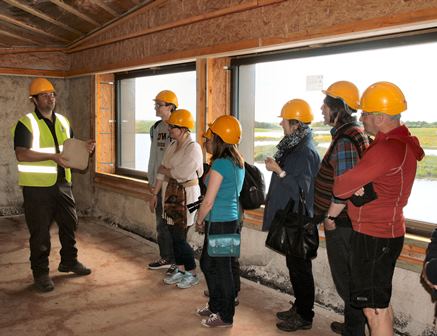
Members of the branch, together with two welcome visitors from the Yorkshire branch, were given a tour of the new facility by Alex Lister, the Druridge Bay reserves manager. Although the centre is still under construction, we were able to see the high standards of eco-build using sustainable local materials including straw insulation, sand/clay flooring, Douglas fir pillars sourced from one of the Trust’s own reserves and a turf roof.
The building has panoramic views over the reserve and, as well as acting as a gateway, will incorporate a shop, café and an education centre.
We were able to take advantage of the glorious weather to round off the day with a tour around the reserve to view the developing flower meadows and lake hides. Some of us even spotted the spotted sand piper!
Dr Michael Rowell CBiol MRSB
AGM and Lecture
9 April 2016
The branch met at the College of St Hild and St Bede, Durham University. After a welcome and introduction by Dr Mike Cassidy, the secretary reviewed the year's activities, which included attendance at the Middlesbrough Imagineer Festival, sponsorship of an animal science conference at Newcastle and a successful and enjoyable Christmas dinner held in Durham to mark the award of the Royal Charter.
The current committee was re-elected and there was discussion about potential and planned activities for the year ahead.
The planned speaker was unfortunately not able to attend but we were fortunate that Mark Whittingham, professor of applied ecology at Newcastle University, and Dr David Brignall, regional director of the consultancy Wardell-Armstrong were able to give a joint talk on the intended theme of ecosystem services.

Mark talked about our understanding of biodiversity and about its human values which can be expressed in terms of both economy and wellbeing. The ways in which biodiversity contributes to these values forms the basis of ecosystem services.
The problems and challenges of biodiversity loss were also explored: David explained the nature of ecosystem services from the perspective of the consultant and the multidisciplinary approach involved in assessing the potential of interconnected and multiple effects of major projects on the environment.
He illustrated these problems and some of the ways in which negative effects can be mitigated with detailed reference to a wind farm project in the Shetlands, and work in Armenia on the development of a gold mine in an ecologically sensitive area.
This perceptive and lively presentation gave considerable insight into a very practical and important area of biology.
Dr Michael Rowell CBiol MRSB
Branch Christmas Celebration
5 December 2015
Members of the Northern branch and their guests celebrated the award of the Royal Charter to the Society at a Christmas dinner in the pleasant surroundings of the Lindisfarne Centre at St Aidan's College, Durham University.
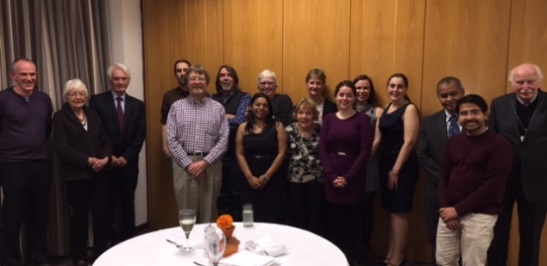
Before the excellent festive meal we were fortunate in being able to view a display of the winning entries in the Society's latest photography and specimen drawing competitions together with the book prize winners. It is a few years since we last had a Christmas gathering and it is hoped that the success of this event will promise many more to come.
Dr Michael Rowell CBiol MRSB
Annual General Meeting and Lecture
18 April 2015
The branch met at Durham University in the Holgate conference centre at Grey College. The AGM was held in the morning and, after a welcome and introduction by the chairman, the year's events were reviewed including successful visits to the Durham brewery in June and to Northumbrian water scientific services in November. We were pleased to welcome Dr Penny Fletcher, Events and public engagement manager for the Society of Biology and Dr Jane Magill, Regional coordinator for Scotland and Northern England who each gave short presentations.
The chairman, Dr Clifford Wood, reported that he would not seek re-election and thanked the current and past members of the committee for their support. He paid particular tribute to the late Professor Donald Lee for his help and guidance. Cliff was thanked for his work and leadership of the branch during his ten years of office following a long period as a committee member.
Professor Sandra Edwards, the Vice Chair, had left the committee during the year as had Dr Douglas Wilson, and Dr Christine Masterson, the Events Secretary, did not wish to continue. Dr Cathleen Thomas and Dr Brian Degger were elected to the committee and the new committee comprises:
- Dr Michael Rowell (currently secretary and treasurer)
- Dr David Brignall
- Dr Mike Cassidy
- Dr Brian Degger
- Mr Greg Pridgeon
- Dr Mosharaf Sarker
- Dr Cathleen Thomas
Mike Rowell indicated that he intended to phase out of office as soon as the new committee was firmly established. No chair was appointed and it was hoped that the official positions could in the future be a matter of shared responsibility. Any members who were unable to be at the meeting but who would like to join the committee would be very welcome.

After a buffet lunch, Professor Olivier Sparagano, Associate Pro Vice Chancellor for Research at Coventry University gave a lecture entitled The Emperor versus the Microbes. Olivier looked at the progression and failures of the Roman Empire and the brilliant successes and setbacks of Napoleon. During wars the main killers are not always soldiers and statistics show that the highest casualties are often the result of disease. He suggested that in counteracting infection the immune system follows the same strategy and that we should therefore learn from the best leaders, build the best armies, gather intelligence and develop new strategies. The body's own soldiers and weapons equate to the innate and adaptive immunity of defending cells and antibodies. The use of new techniques such as molecular diagnostics and vaccine development was illustrated by research against the poultry red mite – a major parasitic pest of economic importance. After a persuasive and entertaining talk the conclusion was that "the more you know about bugs the better to win the battles".
Dr Michael Rowell CBiol MSB
Visit to Northumbrian Water
22 November 2014
Branch member Lisa Bamford arranged for Northumbrian Water Scientific Services to host a visit of the Northern Branch at its dedicated microbiology laboratory at Horsley, in the Tyne Valley.
Though we take the provision of safe drinking water for granted, we can only do so because of the constant treatment and monitoring of the supply. In addition to routine testing of drinking water, the laboratory also offers services testing private water supplies, bathing and environmental waters.
After a welcome with coffee and cakes by the laboratory manager, John Cooper, Lisa and her colleagues John Kain, Bob Carrington, Gemma Calvert and Rachel Brown gave a detailed overview of the processes involved in purifying supplied water and in testing samples. After donning suitable protective gear, we were then taken in groups around the laboratories to see the actual methods used.
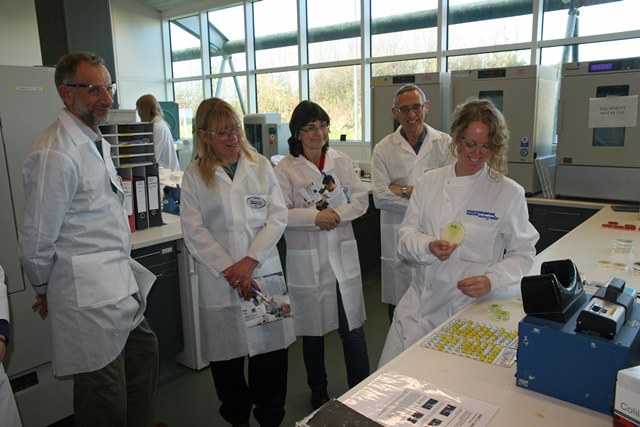
Water is routinely tested for indicators of faecal contamination - coliforms, Enterococci faecalis, and Clostridium perfringens - by using a range of selective media to isolate and confirm these organisms. The laboratory also tests water from public and private supplies for Legionella, the source of Legionnaires disease and a major cause of pneumonia.
Cryptosporidium parvum is commonly found in cow faeces and can cause the disease cryptosporidiosis with ingestion of as few as 10 to 30 oocysts. The parasite is resistant to chlorine and infected water must be boiled. High risk sites are monitored on a daily basis and since cryptosporidium can't be grown on selective media, it has to be isolated by filtration and identified microscopically. We were shown the labour intensive process involved in isolating the organism.
It would be difficult to imagine a world without easily accessible clean water and we are grateful to Northumbrian Water for hosting our visit and allowing us to see the detailed professional care and technology used to ensure our supplies.
Dr Michael Rowell CBiol MSB
Durham Brewery Tour
13 June 2014
Sixteen members and their guests met for a guided tour of The Durham Brewery, an independent family-run microbrewery which has won many awards since it was established by Steve and Christine Gibbs in 1994.
Steve talked about the history and processes of brewing and the growth of the microbrewing industry. During the last 20 years the market has changed dramatically with a decline in the number of large industrial breweries but with a demand for ‘real ale’ stimulating the growth of ‘craft’ brewers. Paradoxically, although there are now more brewers, their low volume enterprises mean that less beer is drunk.
The production of the ‘fermented malt beverage’ is more complex than wine making, and while historically ‘ale’ was a relatively unexciting drink, the treatment of malts, use of novel yeasts and the introduction of hops from the continent meant the flavour and strength of beer could be widely adjusted.
The difference between wine-tasting and beer-tasting is that it is necessary to swallow the product to fully appreciate the taste. So, as we were taken through the ways in which different malts, yeasts and hops affect appearance and taste, the group was able to carry out an empirical assessment of the ingredients.
The introduction was followed by a tour of the brewery.
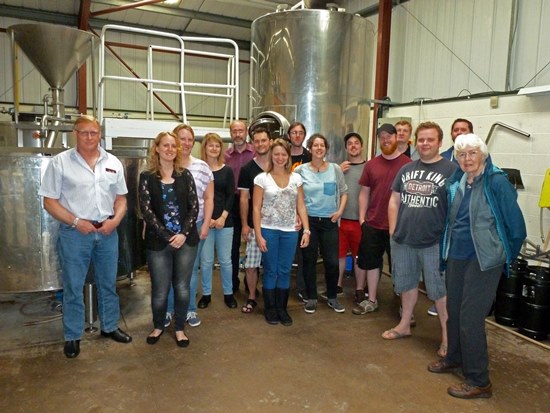
Despite being a very modern plant, the brewery adopts a relatively traditional approach to the technology; the beers are not pasteurized or filtered and the flavours develop by conditioning with live sediment in the bottle or cask. Ongoing experimentation has resulted in a wide range of successful styles with, in some cases, the inclusion of ingredients such as raspberry and mango, and the introduction of an unfiltered wheat beer similar to German Heferweizen.
Following further discussion the group dispersed to their taxis having had an instructive and enjoyable afternoon – a winning experience of practical biotechnology.
Dr Michael Rowell CBiol MSB
AGM
29 March 2014
The Annual General Meeting of the Northern branch was held at the Great North Museum, Hancock, Newcastle upon Tyne. Chairman Dr Cliff Wood reported the death of its honorary president, Professor Donald Lee, in September 2013. Donald had been an active chair, treasurer and for a period, secretary, of the committee – and at one point held all three offices together. In 2011 he was awarded the first of the Society of Biology's President's medal for his services. He will be greatly missed by the branch.
The following members were elected to the Committee: chairman - Dr Clifford Wood; vice chair - Professor Sandra Edwards; secretary - Dr Michael Rowell; events secretary - Dr Christine Masterson; acting treasurer - Dr Michael Rowell.
After the formal business of the meeting, members and their guests moved to the museum planetarium where they viewed the film Fragile Planet.
Michael Rowell CBiol MSB
Animal Health Conference
27 November 2013
Twenty one final year animal science and agriculture students from Newcastle University hosted a conference to discuss current issues relating to animal health.
Within a six week time period we managed to raise £605 in donations, organise a strong and diverse range of guest speakers as well as prepare our own presentations on key topics surrounding our conference title, Animal Health Implications arising from Modern Human Demands.
The topics covered in our group presentations included mobility problems and mastitis in dairy cattle, the housing and welfare of poultry, selective breeding in canines and the health problems of exotic animals.
Leading race horse trainer Mark Johnston spoke on the ailments affecting the equine species and the approach to these in a thoroughbred stable. Nuffield Scholar Paul Robinson talked about his experience in the dairy industry, discussing his research and studies abroad with particular emphasis on the welfare and productivity of cattle in 'mega-dairies'. To conclude the conference, local veterinary surgeon Sam Prescott gave a thought provoking talk on the care and concerns of exotic animals.
The conference attracted a wide variety of guests, including students from colleges in the North East and representatives from organisations such BSAS and of course the Society of Biology.
We would like to thank our donors: BSAS; Society of Biology; Semex; Brooke Research Ltd; and Dr Guy from Newcastle University, without whose generous contributions the conference could not have gone ahead.
Overall, we received some excellent feedback, and we are hopeful that next year's students will be inspired to hold a great conference.
Bethany Count, Charlotte Dolphin & Matthew Sharp
Big Bang NE
3 July 2013
For the last few years, the Northern branch has awarded prizes for the best biology entries at the school science fair, Big Bang North East. This year the event was held at Newcastle University where, in addition to the National Science and Engineering Competition stands, there was an ongoing programme of science shows, workshops and activity zones.
Seventy-three school science and technology projects were on display, sixteen of which were biologically based. The branch secretary and a colleague talked to the enthusiastic exhibitors and - with some difficulty because of the extremely high standard of the entries - drew up a shortlist to recommend to the moderators.
The Northern branch prizes were awarded to Daniel Graham, Jack Bannister, Lucy Evanson, Steven Dixon and Holly French from Whickham School with a project entitled 'Studies of protein synthesis using live cell microscopy; and Olivia Jack, Hannah Schubeler, Beth Robertson, Nathan Smith Francesco Bello and Alfie Briggs from St Thomas More RC Academy with a project, 'Is the red you see the red I see?'.
Michael Rowell CBiol MSB
AGM and visit to Moorbank Botanic Garden
6 April 2013
On a beautiful spring day, eighteen members and their guests were given a tour of Newcastle University's Moorbank Botanic Garden by director, Dr Anne Borland. Moorbank, which lies a short distance from the city centre, houses the rare and extensive plant collections of Randle Cooke which were moved from his noted garden, Kilbryde, near Corbridge in 1973.
 A series of connected glasshouses contain a wide range of plants including the Trevor Walker fern collection. The glasshouses are themed into areas such as tropical rainforest, economic plants, a pond and a desert house. The latter was the inspiration for the Leverhulme sponsored poet in residence, Linda France, whose compilation of renga verse is highlighted by a word sculpture in the desert house.
A series of connected glasshouses contain a wide range of plants including the Trevor Walker fern collection. The glasshouses are themed into areas such as tropical rainforest, economic plants, a pond and a desert house. The latter was the inspiration for the Leverhulme sponsored poet in residence, Linda France, whose compilation of renga verse is highlighted by a word sculpture in the desert house.
In addition to the research being carried out in the gardens, regular activities offer hands-on educational experience in the plant sciences and environmental biology to local schoolchildren and other groups. Unfortunately, Newcastle University is planning to withdraw its support from Moorbank Gardens in November and the future of the site, which is leased from the freemen of Newcastle, is uncertain, but supporters have drawn up a feasibility study to help maintain its present role.
Following the tour, Dr Borland gave a talk entitled why do we need plant scientists? She began by outlining the historic development of plant science and why an understanding of botany is increasingly important to world economy. She then gave a fascinating overview of the ways in which research into photosynthetic mechanisms- particularly CAM processes -can lead to increasing crop yields for both food and biofuels.
A buffet lunch was followed by the AGM. The chairman, Dr Cliff Wood, thanked the committee for their work and reviewed the year's events. He particularly expressed his appreciation to Mrs Muriel Woodward who was retiring from the committee after 25 years service. Dr Mike Cassidy was elected to the committee and the current officers and remaining members were re-elected.
Michael Rowell CBiol MSB
AGM and visit to Northumbrian Water
21 April 2012
Our AGM was held at Northumbrian Water Limited ETW and Advanced Digestion Plant at Bran Sands. Since only seven members were present, and no new nominations were received, the officers and committee were re-elected en bloc. Chair Dr Cliff Wood thanked the committee for their work but expressed concerns over the lack of support from branch members with consequences for the future viability of the branch. We have no Charter Lecture planned for this year although the branch will continue to support Big Bang NE and the student animal health conference.

Members learnt about the Bran Sands site, which lies at the mouth of the River Tees - a heavily industrialised area. Mike Ellner and Bernie Glanville from Northumbrian Water gave a short historical overview of sewage treatment and then detailed the development of the Bran Sands site.
The aim was to improve water quality within 12km of the Tees estuary and to introduce a more sustainable and effective sludge strategy. Prior to 1995, there was no coherent strategy for disposal of sludge with this material being sent to agricultural land, landfill or disposed of at sea. The advanced digestion plant at Bran Sands is a centralised facility utilising anaerobic, anoxic and aerobic biological treatment to deal with a range of organic and inorganic wastes producing clean effluent and a usable sludge for recycling to farmland. Biogas which is generated as a by-product is burnt in a CHP engine and used as a renewable energy source. As well as the economic benefits, the environmental impact can be seen in the quality of the river water with the Tees now supporting healthy salmon stocks and a thriving population of Harbour Seal in the estuary. Members were finally given a tour of this impressive site concluding an informative and rewarding day.
Michael Rowell CBiol MSB


